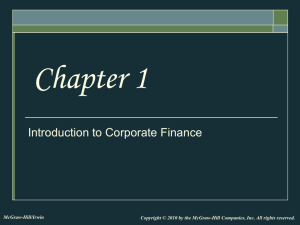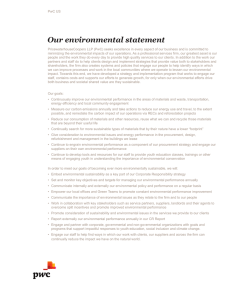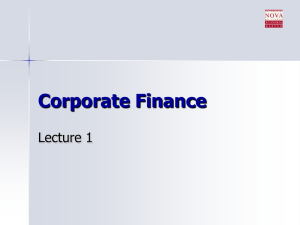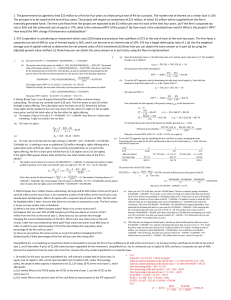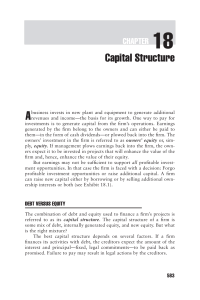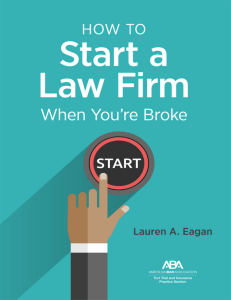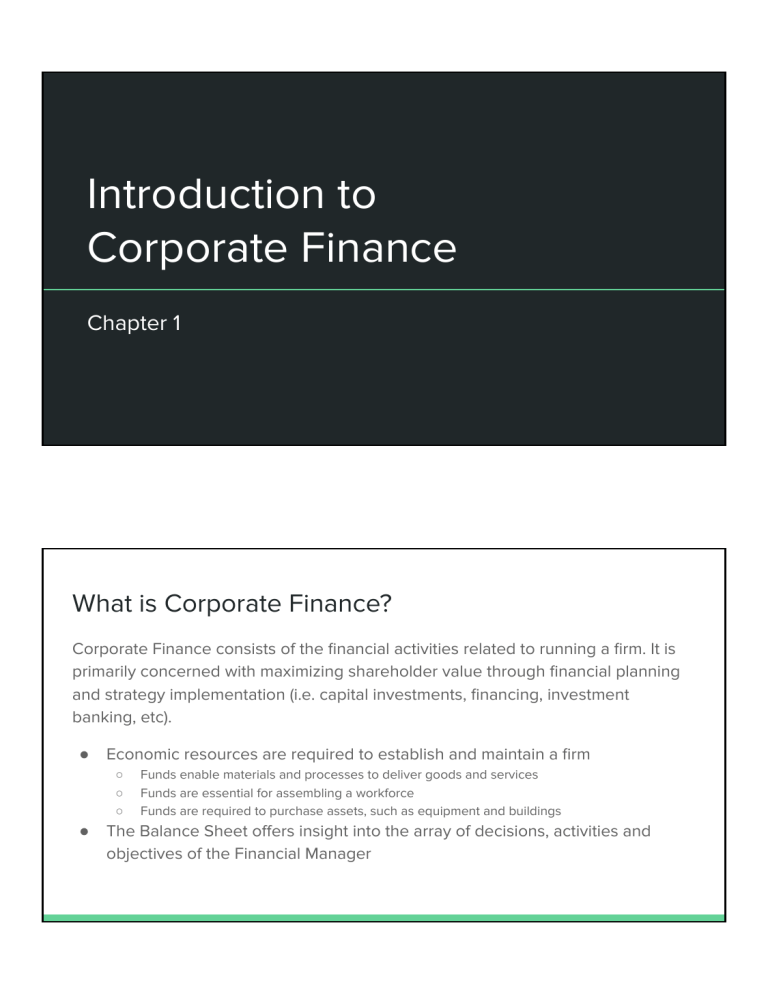
Introduction to Corporate Finance Chapter 1 What is Corporate Finance? Corporate Finance consists of the financial activities related to running a firm. It is primarily concerned with maximizing shareholder value through financial planning and strategy implementation (i.e. capital investments, financing, investment banking, etc). ● Economic resources are required to establish and maintain a firm ○ ○ ○ ● Funds enable materials and processes to deliver goods and services Funds are essential for assembling a workforce Funds are required to purchase assets, such as equipment and buildings The Balance Sheet offers insight into the array of decisions, activities and objectives of the Financial Manager Concerning Corporate Finance The top three concerns of corporate finance: 1. Capital Budgeting a. What long-term investments should the firm choose? 2. Capital Structure a. How should the firm raise funds for the selected investments? 3. Net Working Capital a. How should operating cash-flow be managed? The Balance Sheet Model Total Value of Assets Total Firm Value to Investors Current Liabilities Current Assets Long-Term Debt Fixed Assets (tangible + intangible) Shareholders’ Equity The Capital Budgeting Decision Total Value of Assets Total Firm Value to Investors Current Liabilities Current Assets Long-Term Debt Fixed Assets (tangible + intangible) What long-term investments should the firm choose? Shareholders’ Equity The Capital Structure Decision Total Value of Assets Total Firm Value to Investors Current Liabilities Current Assets How should the firm raise funds for the selected investments? Fixed Assets (tangible + intangible) Long-Term Debt Shareholders’ Equity Net Working Capital Total Value of Assets Total Firm Value to Investors Current Liabilities Current Assets NWC Fixed Assets (tangible + intangible) Long-Term Debt How should operating cash-flow be managed? Shareholders’ Equity The Financial Manager The Financial Manager’s primary goal is to increase the value of the firm. 1. Selecting value-creating projects 2. Making intelligent financing decisions The Corporate Firm The corporate form of a business is the standard method for solving the problems associated with raising large amounts of cash. Businesses can take other forms. ● ● Sole Proprietor Partnership ○ ○ ● ● Limited General Corporation Limited Liability Company* The Importance of Cash Flow The successful company generates more cash than it uses. If a company is to be successful and prosper, it must: ● ● Purchase assets that generate more cash than they cost Sell financial instruments that raise more cash than they cost The Firm and the Financial Markets Firm Invests in Assets (B) Current Assets Fixed Assets Firm issues securities (A) Financial Markets Retained cash flows (E) Cash flow from firm (C) Dividends and debt payments (F) Short-Term Debt Long-Term Debt Equity Shares Taxes 🙁 Total Value of Assets Government (D) Total Firm Value to Investors The Goal of Financial Management is to... Maximize Shareholder Wealth Shareholders vs. Stakeholders Does maximizing shareholder wealth imply taking extreme positions toward other claimants? No Balancing Interests Agency Relationship The Agency Problem The Corporate structure is characterized by the separation of Ownership and Control ● ● Principal hires agent to represent his/her interest Stockholders (principals) hire managers (agents) to run the company Agency Problem ● Conflict of interest between principal and agent The Agency Problem Principals Agents Board of Directors Vote Stockholders Hire Cash Stock ^ Dividend ^ Corporation Run Managers Managing Managers Managerial compensation ● ● Incentives can be used to align management and stockholder interests The incentives need to be structured carefully in order to achieve their intended goal Corporate control ● The threat of a takeover may result in better management Influence of other stakeholders Regulation The Securities Act of 1933 and the Securities Exchange Act of 1934 ● ● Issuance of Securities (1933) Creation of SEC and reporting requirements (1934) Sarbanes-Oxley (“Sarbox”) ● ● Increased reporting requirements and responsibility Personal consequences for non-compliance
